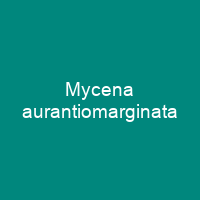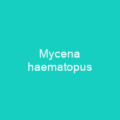Mycena aurantiomarginata: A Golden-Edge Bonnet in the Forest
Imagine a forest floor carpeted with tiny, delicate mushrooms, each one a masterpiece of nature’s artistry. One such species is Mycena aurantiomarginata, known as the golden-edge bonnet. This fascinating fungus has been captivating mycologists and mushroom enthusiasts for centuries due to its unique characteristics and intriguing history.
Discovery and Naming
Was it love at first sight when this species was discovered in 1803? Or perhaps a more scientific approach led to its formal naming in 1872? Regardless, the name Mycena aurantiomarginata is a testament to the vibrant colors of nature. The specific epithet ‘aurantiomarginata’ translates to ‘orange-edged,’ referring to the distinctive bright orange edges on its gills.
Description and Habitat
Can you picture this mushroom in your mind’s eye? With a cap that can be dark olive fuscous or yellowish-olive, often with an orangish margin, it stands out among the forest floor. The stipe is brownish to grayish-olive with shades of orange, and the spores are elliptic, smooth, and amyloid.
The Mycena aurantiomarginata grows on coniferous forest floors, scattered or in groups, making it a common sight for those who venture into such environments. Its habitat spans North America, Europe, Central America, Costa Rica, Japan, and Africa, showcasing its adaptability to various climates.
Pigments and Antibiotic Activity
What secrets lie within the golden-edge bonnet? A novel pigment called mycenaaurin A was discovered in this mushroom. This pigment is responsible for its vibrant color and exhibits antibiotic activity, making it a fascinating subject of study.
The presence of mycenaaurin A suggests that Mycena aurantiomarginata has evolved to defend itself against certain bacteria, such as Bacillus pumilus. The chemical is only present in fruit bodies and shows weak antimicrobial activity against Candida albicans and Aspergillus fumigatus.
Molecular Analysis and Mycorrhizal Partnerships
How does this mushroom interact with other organisms? Research has shown that Mycena aurantiomarginata can be a mycorrhizal partner of the orchid Gastrodia confusa. This relationship highlights the complex web of interactions in forest ecosystems, where fungi and plants form symbiotic relationships to thrive.
The species is classified in section Calodontes, subsection Granulatae, with similar characteristics to other species like Mycena rosella and Mycena flavescens. This classification helps mycologists understand the evolutionary history and relationships within this group of fungi.
Culture and Hyphae
What happens when you grow these mushrooms in a controlled environment? When cultivated, colonies are white with congested aerial hyphae that flatten to submerged hyphae. Hyphae form deposits of tiny amorphous crystals, especially when incompatible, causing lysis.
The structure of the mushroom is fascinating, with a layer of enlarged cells directly beneath the cuticle and filamentous hyphae beneath this layer. Clamp connections are present in the hyphae, indicating a complex genetic makeup that allows for diverse mating systems.

In conclusion, Mycena aurantiomarginata is a remarkable species that continues to intrigue scientists and nature lovers alike. Its vibrant colors, unique pigments, and complex interactions with other organisms make it a valuable subject for further study. As we continue to explore the natural world, mushrooms like this one remind us of the endless wonders hidden in plain sight.
You want to know more about Mycena aurantiomarginata?
This page is based on the article Mycena aurantiomarginata published in Wikipedia (retrieved on November 27, 2024) and was automatically summarized using artificial intelligence.







